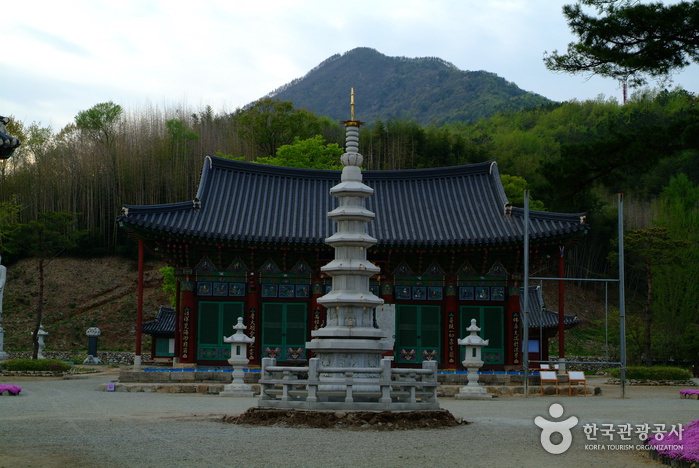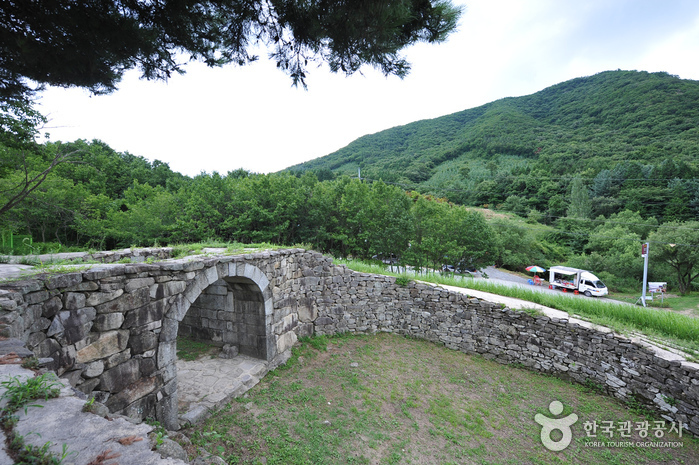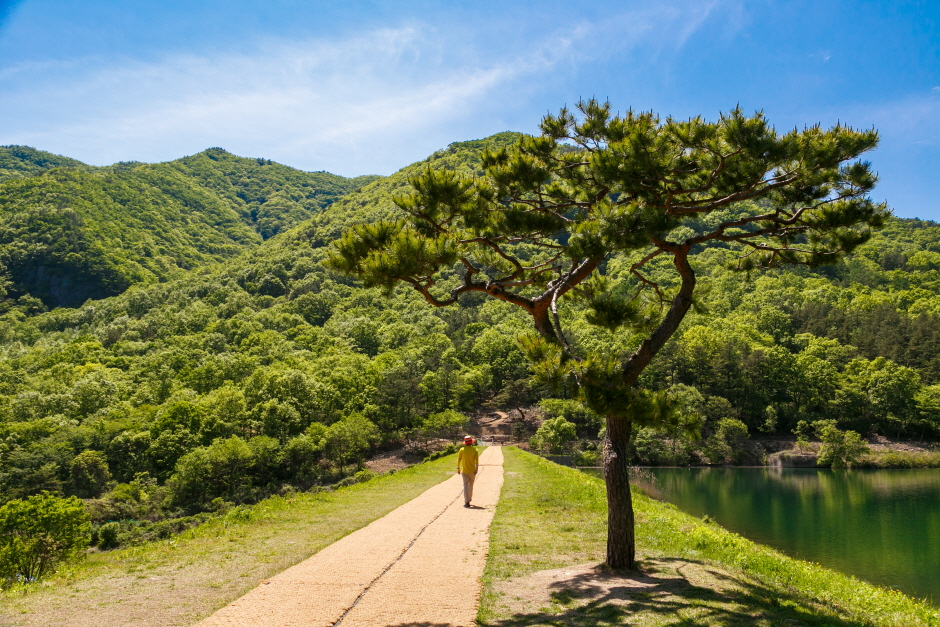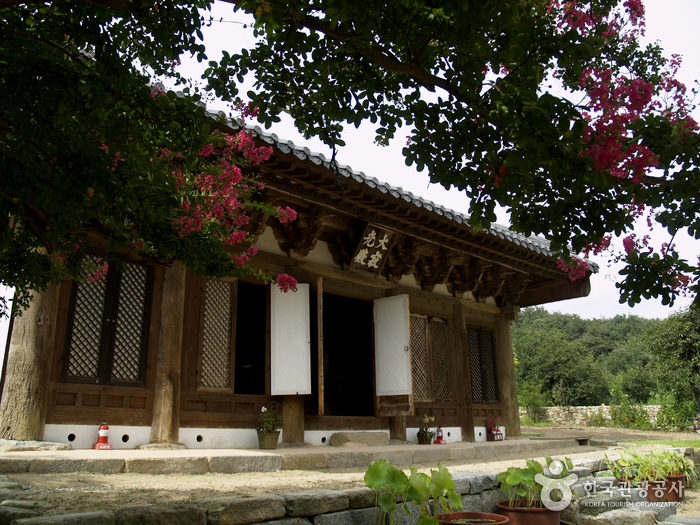King of young jo [Korea Quality] / 영조관 [한국관광 품질인증]
8.9 Km 289 2024-04-07
5218-12, Chunhyang-ro, Wansan-gu, Jeonju-si, Région Jeonbuk
+82-63-284-1004
Yeongjogwan is one of the 11 buildings located within the Korean traditional hotel ‘Royal Room Of King’, with a view over the Jeonjucheon Stream. The hotel has 11 buildings named after the historical kings of Joseon Dynasty, and Yeongjogwan, named after the 21st king of Joseon, has two rooms: The Gold Room, and the Silver Room. Both rooms feature a design that tastefully integrates the Korean traditional hanok construction with modern techniques. The Gold Room, located on the 2nd floor of the building, is dominated by the exposed wooden beams under the roof, while the 1st floor’s Silver Room has a lower ceiling than the Gold Room, and thus feel cozier. Each unit is made up of a bedroom with two double beds, living room with low tables and seats, and a whirlpool bathroom. The bathroom is equipped with whirlpool bath and shower facilities and is separate from the toilet. The bedroom and the living room are separated by a traditional screen covered with hanji, traditional paper of Korea. Amenities in the unit include a refrigerator, electric kettle, and hairdryer.
The lawn outside is furnished with traditional plays like Yutnori, Tuho, Neolttwigi, and Gamatagi. There are two restaurants and a cafe within the hotel complex, allowing the guests to enjoy their meal in the comfort and grandeur of Korean architecture. One of the restaurants, Hyangwonjeong, offers a sumptuous breakfast spread including salads, namul (vegetable side dishes), jeon (pancakes and battered items), bread, and bacon. The hotel complex is located close to major tourist attractions of Jeonju; a 5-minute drive gets one to Jeonju Hanok Village, Nambu Market, and Pungnammun Gate.
Jeongjogwan of the Royal Room [Korea Quality] / 왕의지밀 정조관 [한국관광 품질인증/Korea Quality]
8.9 Km 0 2024-04-08
5218-10, Chunhyang-ro, Wansan-gu, Jeonju-si, Région Jeonbuk
+82-63-284-1004
This hanok (traditional Korean house) hotel shows a different interpretation of hanok’s traditional beauty from Jeonju Hanok Village. The name of the hotel encapsulates Jeonju’s spirit as a city of tradition and art, and the exemplar of the state of Joseon. The hotel complex stands on a plot of land spanning 19,840 m2, containing 11 residential buildings and other facilities like hanok restaurants. Each residential building is named after the kings of the Joseon Dynasty. Jeongjogwan contains six rooms,
all built to modern comfort for all age groups. Grade 2 Silver and Gold Rooms, which can house up to 6 guests, are especially popular for families. The rooms combine modern comfort with hanok aesthetics, like wooden exposed beams and wooden furniture, which help to fill the room with the elegant fragrance of wood.
The hotel has about 150 parking spots, a hanok cafe, and the Convention Center with spaces such as Daejanggeum Hall, Saimdang Hall, Chungmugong Hall, and Hunminjeongeum Hall. Samtaegeuk and Samjogo Restaurants are designated as COVID-19 Safe Restaurants by the city of Jeonju. Jeonju Hanok Village is reachable by car in about 7 min.
Gojonggwan of the Royal Room [Korea Quality] / 왕의지밀 고종관 [한국관광 품질인증/Korea Quality]
9.0 Km 0 2024-04-07
5218-8, Chunhyang-ro, Wansan-gu, Jeonju-si, Région Jeonbuk
+82-63-284-1004
This hanok (traditional Korean house) hotel was opened in 2018. Its location near Jeonju Hanok Village, the central point of Jeonju tourism, gives it excellent access to destinations in Jeonju. As evident from its name, the hotel promises a comfortable stay in a hanok. The hotel complex stands on a plot of land spanning 19,840 m2, containing 11 residential buildings and other facilities.
Each residential building is named after the kings of the Joseon Dynasty. Gojonggwan, named after King Gojong, contains six rooms. The rooms are divided into Gold and Silver Rooms, and are classified into Grade 2, Grade 3, and Grade 5 rooms, all including bathrooms and restrooms in addition to bedrooms. The rooms are furnished to offer the unique aesthetics of hanok in modern comforts. The view of the wooden exposed beams (Gold Room), wooden furniture, and the sunlight from the window wall offer an insight into the beauty of Korea’s traditional residence. All rooms are also equipped with modern comforts such as wireless Internet, TV, refrigerator, and air conditioning.
The hotel also boasts a wide array of facilities, including a spacious parking lot with a capacity of about 150 cars, a hanok cafe serving coffee and traditional tea, and the Convention Center with spaces, such as Daejanggeum Hall and Chungmugong Hall, which offers ideal venues for seminars and other large events. The two hanok restaurants on the premise, Samtaegeuk and Samjogo Restaurant, are designated as COVID-19 Safe Restaurants by the city of Jeonju. It takes only 10 min by car to reach most tourist sites in Jeonju Hanok Village.
Sunjonggwan of the Royal Room [Korea Quality] / 왕의지밀 순종관 [한국관광 품질인증/Korea Quality]
9.0 Km 1 2024-04-07
5218-6, Chunhyang-ro, Wansan-gu, Jeonju-si, Région Jeonbuk
+82-63-284-1004
This hanok (traditional Korean house) hotel is located near Jeonju Hanok Village. The hotel complex stands on a plot of land spanning 19,840 m2, containing 11 residential buildings and other facilities. Modern hanok buildings are built on a line, blending with the surrounding nature to offer a comfortable stay. The name of the hotel is evident in the 11 residential buildings, all named after the kings of the Joseon Dynasty.
Sunjonggwan has six rooms in total. The rooms are divided into Gold and Silver Rooms, and are classified into Grade 2, Grade 3, and Grade 5 rooms, after the grading system used for government officials during the Joseon Period. Gold Rooms are located on the second floor, while the 1st floor is occupied by the Silver Rooms. Each room is furnished with a combination of hanok’s unique charms and modern comfort. Exposed wooden beams fill the room with a gentle scent of wood, while window walls offer an expansive view of the scenery outside.
Restaurants such as Samtaegeuk Restaurant, the site of the hotel’s breakfast offering, and Samjogo Restaurant, a Korean restaurant serving lunch and dinnertime, are designated as COVID-19 Safe Restaurants by the city of Jeonju. The Convention Center, which houses a hanok cafe, also offers a number of different facilities for the guests. It takes only 10 min by car to reach most tourist sites in Jeonju.
Rizerie Saekjang (색장정미소)
9.7 Km 0 2024-04-08
2-15, Wonsaekjang-gil, Wansan-gu, Jeonju-si, Région Jeonbuk
La rizerie Saekjang se situe à environ 5 minutes du village des hanok de Jeonju. L'endroit est désormais un café construit sur les bases d'une rizerie datant des années 1950. Le café sert aussi de lieu d'expositions notamment autour de la photographie.
Happydream [Korea Quality] / 행복드림한옥 [한국관광 품질인증]
10.8 Km 9895 2024-04-07
181-21, Bongseoan-gil, Yongjin-eup, Wanju-gun, Région Jeonbuk
+82-10-3677-5339
The Dueok Happy Dream Village Farming Association Corporation runs a hanok-style guesthouse situated in Dueok Happy Dream Village, which is surrounded by high, clean mountains. Also known as Bongseogol, the village is a pleasant farming community located deep in the lush green mountains of Wanju-gun, Jeollabuk-do, and is also well known as one of the eight best propitious sites in Korea – Jongnamsan Mountain on its right and Seobangsan Mountain on its left are said to resemble a phoenix('Bonghwang' in Korean) embracing the village (hence the name of the village is ‘Bongseo’).
Dueok Village was re-born as Dueok Happy Dream Village as part of the rural village revitalization project carried out in Wanju County. The village has jointly run diverse hanok buildings (ranging from about 45 to 150 years old) as hanok-style guesthouses, along with various hands-on programs, since 2010. The Dueok Happy Dream Village Farming Association Corporation now runs the guestrooms and a large experience center, and only accepts groups of guests. The experience center offers education programs on traditional etiquette, and also operates reenactments of the ancient civil service examination. It also offers guests three good meals a day consisting of rural-style healthy food served with wild vegetables and various side dishes at a reasonable price.
The guesthouse comprises tile-roofed houses on both sides set amid a large grassy field against a background of green mountains. The guestrooms feature a simple yet pleasant design and are equipped with ondol (under-the-floor heating) without air-conditioning. The experience center is notable for its ten doors which can be opened by lifting them up toward the ceiling, thereby providing an open view of the beautiful landscape.
Furthermore, the village, which has been designated as a rural experience and recreational village, runs a wide variety of hands-on programs, including a Nature Experience program consisting of a forest tour with a guide, Making a Wish Necklace, Walking on the Myeongdang (propitious site), Rice Farming, Digging Sweet Potatoes, Traditional Folk Games (archery, steel hoop rolling), Rice Cake Pounding, Making Scarecrows, and Making a Kite, among others. It also offers Sori Hakdang and etiquette education programs as a two-day course.
Temple Songgwangsa (Wanju) (송광사(완주))
12.6 Km 14494 2024-04-07
255-16, Songgwangsuman-ro, Wanju-gun, Région Jeonbuk
+82-63-243-8091
Le temple Songgwangsa se trouve à Soyang-myeon, Wanju-gun dans la province du Jeollabuk-do. Le temple est vieux de plus de mille ans. Seul le terrain du temple avait été conservé jusqu’à la 7ème année du règne du roi Gyeongmun de Silla (867), quand le moine Bojo Cheijing l’a reconstruit. Au fil du temps, le temple fut quasiment détruit, mais le grand moine Jinul pria pour sa reconstruction. Les halls et bâtiments restants ont été construits par les disciples du moine Jinul dans les années 1600. Le temple est également réputé du fait que le roi Injo a contribué à sa reconstruction dans l’espoir que ses deux fils, qui avaient été pris en otage par la dynastie Qing durant la guerre Byeongjahoran (invasion de la Corée par la Chine en 1636) reviennent sains et saufs, et que Bouddha soulage les tourments de la guerre.
Songgwangsa est l’un des quatre principaux temples de Corée, et abrite les statues de Jijangbosal et Siwangsang conservées dans le hall Jijangjeon (le plus grand hall), la statue Seokgayeorae et les 500 statues Nahansang dans le hall Nahanjeon et le hall Daeungjeon, chacune d’entre elles attirant des foules d’adorateurs. Le temple se trouve sur un terrain plat, et il est ainsi facilement accessible aux personnes âgées. Au printemps, les tunnels de cerisiers en fleurs sont tout simplement magnifiques. Le temple abrite également quatre trésors culturels : le hall Daeungjeon, les statues Samsebulsang, le clocher et la statue Sacheonwangsang, ainsi que huit biens culturels tangibles.
Parc national Uibongsanseong (위봉산성군립공원)
12.7 Km 24439 2024-04-07
Région Jeonbuk, Wanju-gun, Soyang-myeon, Wondaeheung-gil 136-3
Le parc national Uibongsanseong, situé à Jeonju, est un site prisé pour les longues promenades au milieu de la nature et des arbres de saison, notamment les arbres de cerisiers.
Oseongje Jeosuji (오성제 저수지)
13.1 Km 0 2024-04-07
Région Jeonbuk, Wanju-gun, Soyang-myeon, Daeheung-ri
L'espace Oseongje Jeosuji désigne un espace de repos et de promenade à Wanju. Le lieu est réputé pour ses zones de photo mais aussi pour avoir servi de lieu de tournage pour le groupe BTS en 2019 (Summer Package).
Temple Gwisinsa (귀신사)
13.3 Km 6015 2024-04-07
40, Cheongdo6-gil, Geumsan-myeon, Gimje-si, Région Jeonbuk
+82-63-548-0917
Gwisinsan, situé dans le village Cheongdo à Gimje, est actuellement un temple de l’ordre Jogye mais fut initiallement crée en appartenance à l’ordre Hwaeom. Il est réputé de par son créateur le grand moine Uisang Daesa et fut construit lors de la 16ème année du règne du roi King Munmu (676). Cependant, certains soutiennent que ce temple fut fondé de manière privée pour la famille royale sous le règne du roi Beop du royaume Baekje.
La statut Namgeunseok d’un animal de pierre est présentée pour soutenir cet argument.
Historiquement, le temple a eu plusieurs noms dont Guksinsa, Gwisinsa, Gusunsa et Gwisinsa (avec un sens différent), mais on sait peu de choses sur le temple lorsqu’il avait des noms différents. Actuellement, le temple contient une pagode en pierre de 3 étages et quelques sculptures incluant seoksu (statut animale en pierre) et Buto. Egalement, on retrouve le hall Daejeokgwangjeon à l’intérieur du temple, désigné comme le trésor n°826 de Corée, le hall Myeongbujeon et une chambre Gongyangjib (chambre d’offrandes bouddhistes).
![King of young jo [Korea Quality] / 영조관 [한국관광 품질인증]](http://tong.visitkorea.or.kr/cms/resource/90/2637390_image2_1.jpg)
![Jeongjogwan of the Royal Room [Korea Quality] / 왕의지밀 정조관 [한국관광 품질인증/Korea Quality]](http://tong.visitkorea.or.kr/cms/resource/44/2705944_image2_1.jpg)
![Gojonggwan of the Royal Room [Korea Quality] / 왕의지밀 고종관 [한국관광 품질인증/Korea Quality]](http://tong.visitkorea.or.kr/cms/resource/37/2705937_image2_1.jpg)
![Sunjonggwan of the Royal Room [Korea Quality] / 왕의지밀 순종관 [한국관광 품질인증/Korea Quality]](http://tong.visitkorea.or.kr/cms/resource/59/2706059_image2_1.jpg)

![Happydream [Korea Quality] / 행복드림한옥 [한국관광 품질인증]](http://tong.visitkorea.or.kr/cms/resource/23/2576423_image2_1.jpg)




 Français
Français
 한국어
한국어 English
English 日本語
日本語 中文(简体)
中文(简体) Deutsch
Deutsch Español
Español Русский
Русский